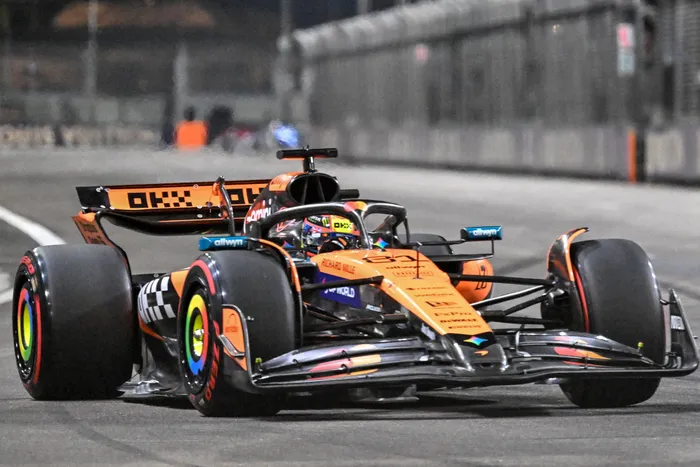McLaren seize early edge over Red Bull in Singapore free practice around Marina Bay
Strategy will be key on Sunday

McLaren driver Oscar Piastri put his foot down during practice at the Formula One Singapore Grand Prix at the Marina Bay Street Circuit.
Image: AFP
Friday’s free practice sessions in Singapore offered a fascinating glimpse into the balance of power between McLaren and Red Bull, with both teams pushing their cars to the limit around Marina Bay’s unforgiving walls.
The tight corners and searing heat of this iconic street circuit make tyre management a critical factor, and early signs suggest the battle for supremacy will hinge as much on strategy as on outright pace.
In FP1, McLaren showed steady progress without fully lighting up the timesheets. Oscar Piastri slotted into fifth, just a thousandth of a second behind Lewis Hamilton’s Ferrari, while Lando Norris followed closely in sixth.
Red Bull, meanwhile, had Max Verstappen in third with a 1:31.392, just a couple of tenths off Fernando Alonso’s session-leading Aston Martin. Yuki Tsunoda rounded out the top ten in ninth.
The gap between McLaren and Red Bull wasn’t vast, but Verstappen held the early edge in consistency. The real shift came in FP2, when McLaren switched to softer tyres for qualifying-style runs.
Piastri delivered a stunning 1:30.714 to top the times, with Norris narrowly behind—just 0.007 seconds adrift of his teammate. Verstappen had to settle for third, unable to match McLaren’s one-lap pace on the same compound. For the first time this weekend, McLaren looked like the team to beat, particularly with the soft tyres bolted on.
Tyre choice played a major role in the contrasting sessions. In FP1, most teams, including both McLaren and Red Bull, began on the hard compound to gather long-run data and assess durability.
Later, both switched to the red-walled softs for their flying laps, with Piastri, Norris and Tsunoda all setting their best times on the softer rubber. Verstappen also ran the softs, but his deficit to McLaren in FP2 suggested either set-up differences or that McLaren had unlocked more potential through Singapore’s trickiest sectors.
The sector breakdown revealed further clues about where performance was gained and lost. Norris was quickest through Sector 2 in FP1, underlining McLaren’s strength in the technical middle portion of the lap, where precision and grip are paramount.
Red Bull, by contrast, failed to top any of the sectors—an unusual sign for a team that typically excels at stringing together complete laps. Verstappen remained competitive overall but lacked outright pace in individual segments of the track.
All of this sets up an intriguing strategic weekend. Tyres around Singapore degrade quickly in the oppressive heat, and the circuit’s stop-start nature makes traction a precious commodity. McLaren’s ability to switch the softs on early could hand them a decisive edge in qualifying, but over a long race stint, Red Bull’s reputation for managing degradation may tilt the balance back in their favour.
The challenge will be whether to lean heavily on the softs for track position, or build a race strategy around the more durable mediums and hards, controlling proceedings from the pit wall. With Verstappen chasing crucial championship points, every strategic call will matter.
McLaren’s strong showing on Friday has put them firmly in the conversation for pole—and possibly the win—but Red Bull’s consistency suggests this duel is far from settled. In Singapore, where mistakes are punished instantly and tyre life dictates survival, the team that masters the rubber is the one most likely to walk away with the advantage.
Related Topics: